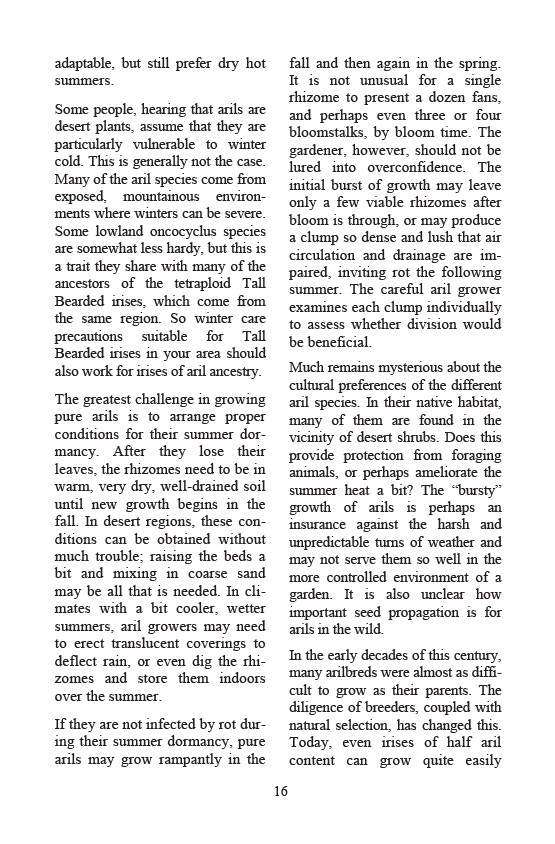
16
adaptable, but still prefer dry hot
summers.
Some people, hearing that arils are
desert plants, assume that they are
particularly vulnerable to winter
cold. This is generally not the case.
Many of the aril species come from
exposed, mountainous environ-ments
where winters can be severe.
Some lowland oncocyclus species
are somewhat less hardy, but this is
a trait they share with many of the
ancestors of the tetraploid Tall
Bearded irises, which come from
the same region. So winter care
precautions suitable for Tall
Bearded irises in your area should
also work for irises of aril ancestry.
The greatest challenge in growing
pure arils is to arrange proper
conditions for their summer dor-mancy.
After they lose their
leaves, the rhizomes need to be in
warm, very dry, well-drained soil
until new growth begins in the
fall. In desert regions, these con-ditions
can be obtained without
much trouble; raising the beds a
bit and mixing in coarse sand
may be all that is needed. In cli-mates
with a bit cooler, wetter
summers, aril growers may need
to erect translucent coverings to
deflect rain, or even dig the rhi-zomes
and store them indoors
over the summer.
If they are not infected by rot dur-ing
their summer dormancy, pure
arils may grow rampantly in the
fall and then again in the spring.
It is not unusual for a single
rhizome to present a dozen fans,
and perhaps even three or four
bloomstalks, by bloom time. The
gardener, however, should not be
lured into overconfidence. The
initial burst of growth may leave
only a few viable rhizomes after
bloom is through, or may produce
a clump so dense and lush that air
circulation and drainage are im-paired,
inviting rot the following
summer. The careful aril grower
examines each clump individually
to assess whether division would
be beneficial.
Much remains mysterious about the
cultural preferences of the different
aril species. In their native habitat,
many of them are found in the
vicinity of desert shrubs. Does this
provide protection from foraging
animals, or perhaps ameliorate the
summer heat a bit? The “bursty”
growth of arils is perhaps an
insurance against the harsh and
unpredictable turns of weather and
may not serve them so well in the
more controlled environment of a
garden. It is also unclear how
important seed propagation is for
arils in the wild.
In the early decades of this century,
many arilbreds were almost as diffi-cult
to grow as their parents. The
diligence of breeders, coupled with
natural selection, has changed this.
Today, even irises of half aril
content can grow quite easily